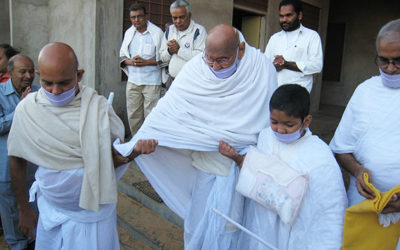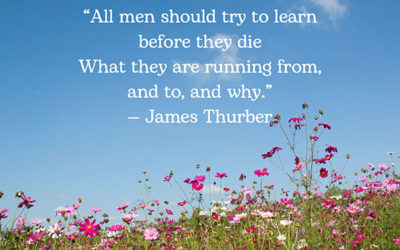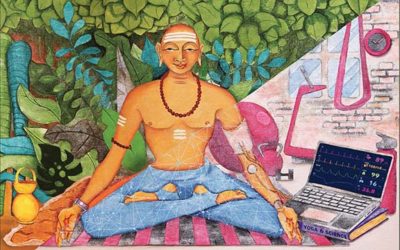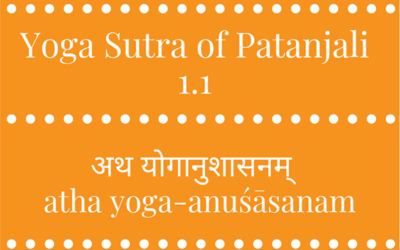Retaining what we’ve learned about the yamas, we now train our attention on the niyamas which occur in sutra 2.32. When prefixed to a noun “ni” can be a negation. It also means “down, back, in, into, within.” Thus, niyama is traditionally rendered “observances”...
Light on the Yamas & Niyamas—Satya: What About Truth?
Satya, truth, stands second in Patanjali’s list of virtues or “restraints.” Most often rendered with respect to speech, like ahimsa, satya broadens to include thought and deed. Under the rubric of ahimsa, the commentators advocate that truth not be spoken unkindly,...
Living Yoga in a Busy World: My Dog is my Spirit Guide
In this new column for Integral Yoga Magazine, "Gita in the Garden, Living Yoga in a Busy World," Yoga teacher Gita Brown shares her reflections on, well, living your Yoga. In each installment, she will share what her Yoga study and practice has revealed to her about...
Light on the Yamas & Niyamas: Awakening to Ahimsa
In this column, Rev. Dale Ann Gray offers reflections on the yamas and niyamas of the Yoga Sutras, incorporating insights from classical Nondual Yoga. In this article, she unpacks the first yama, ahimsa (non-violence, non-harming). In the Yoga Sutras of Patanjali,...
Raja Yoga’s Essential Teaching: The Quest for Happiness
In this 3rd installment of this series on "Raja Yoga Now," Swami Karunananda encourages our readers to explore what they are truly searching for in life. And, to consider how the teachings of Raja Yoga can support one's inner exploration and spiritual journey. What do...
Light on the Yamas & Niyamas: Introduction
In this new column, Dale Ann Gray offers reflections on the yamas and niyamas of the Yoga Sutras, incorporating insights from classical Nondual Yoga. In this article, she offers an overview on the distinctions between the dualistic philosophy of Patanjali’s Yoga and...
The Science of Yoga, Part 1: Yogabhyasa and Yogavidya
The practice of Yoga and the science of Yoga, or Yogabhyasa and Yogavidya, are two of the traditional ways that Yoga is described. Yoga is a practice (abhyasa) and a science (vidya). While asanas and pranayama are immensely popular and currently the most visible...
Raja Yoga Now: The Beginning
The Yoga Sutras of Patanjali begins with a call that reverberates through the ages: Atha Yoganusasanam: Now the exposition of Yoga is being made. It is an invitation to seekers of truth everywhere, irrespective of place, time or circumstance. It offers a universal...
Raja Yoga Now: The Master’s Touch
It was in September 1970 that I first met my spiritual master. It was a time when many great Gurus were being drawn to the West, attracted by the awakening aspiration of the youth. Several hundred of us had gathered at a rustic site in the mountains of California for...
Sustaining a Spiritual Vision
For most of us, this effort requires patience, persistence, and some means to renew this commitment. The obstacles are many: the countless stressors of daily life, the subconscious beliefs and habitual thinking that compel us to defend the ego-identity we’ve formed,...
The Psychology of the Yoga Sutras
The late Michael Stone understood that we all crave to forget about ourselves and to connect with something larger than the way we represent ourselves, yet, we constantly put obstacles in our own way. That’s why we need Yoga, and it’s also why we need to approach Yoga...
Right Relationship with Our Bodies
In this episode of the "Two Old Fogey Yogis" podcast, our two yogis continue their discussion of aparigraha, the fifth and final yama, with an examination of two of its very subtle aspects: the teaching of not receiving gifts, and of one’s relationship to the physical...
Navigating Difficult Situations Utilizing Satya (Truthfulness)
In an earlier episode of their podcast, the "Two Old Fogey Yogis" did a deep dive into satya, truthfulness. Now, they apply this principle to difficult situations. After sharing a bit of philosophy, they ask the question: “What does this really look like in real life?...
Asteya (Non-Stealing) or Getting Everything You Need Without Stealing
Asteya is one of the five yamas, or ethical precepts that are at the foundation of the Yoga system presented by Sri Patanjali, in the Yoga Sutras. Simply put, asteya means to not steal. But, was Patanjali talking about not robbing a bank or more subtle aspects of this...
Satya: Living Truthfully, Living Your Authentic Life
Truthfulness is something lauded by most wisdom paths but what does it really mean to be living truthfully—in one’s life, relationships, and in following your bliss? The "Two Old Fogey Yogis" explore the many aspects and layers of satya, including living as...
Relationships or When Ahimsa Meets Satya
Interpersonal relationships can be challenging to navigate especially when trying to live our Yoga. Yoga’s first foundational limb is yama, which has five practices–the first being ahimsa or non-violence. In Episode 15 of the "Two Old Fogey Yogis" podcast, our two...
















